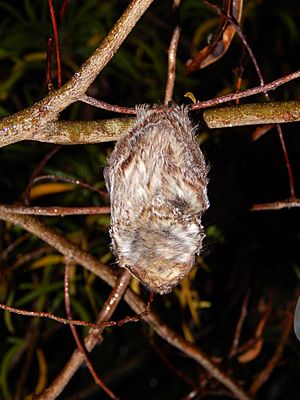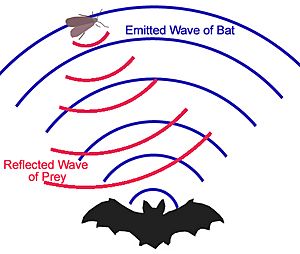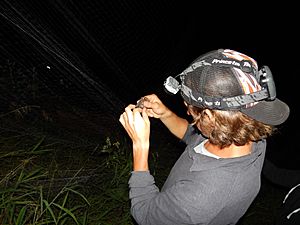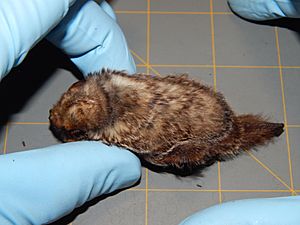Hawaiian hoary bat facts for kids
Quick facts for kids Hawaiian hoary bat |
|
|---|---|
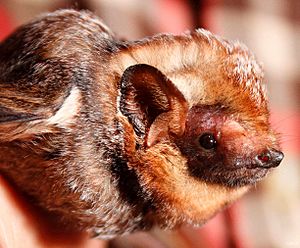 |
|
| Conservation status | |
| Scientific classification | |
| Genus: |
Lasiurus
|
| Species: |
semotus
|
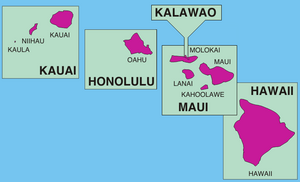 |
|
| Distributed throughout Hawaiian islands | |
| Synonyms | |
|
Atalapha semota Allen, 1890 |
|
The Hawaiian hoary bat (Lasiurus semotus), also known as ʻōpeʻapeʻa, is a special type of bat found only in the Hawaiʻi islands. It's the only native land mammal in Hawaiʻi!
Unlike other hoary bats found across North and South America, the Hawaiian hoary bat lives only on Hawaiʻi's main volcanic islands. In 2015, it was named the official state land mammal of Hawaiʻi. Sadly, it is an endangered animal in the United States.
Hawaiian hoary bats are mostly brown. But they have cool silver fur that looks like frost on their backs, ears, and necks. They are small, weighing about 14 to 18 grams (like a few quarters). Their wingspan is about 10.5 to 13.5 inches wide. Female bats are usually bigger than males.
These bats eat only insects, so they are called insectivores. They are also nocturnal, meaning they are active at night. They hunt for food using echolocation, which is like using sound waves to "see" in the dark.
Hawaiian hoary bats are shy and live alone, not in big groups. They can be found in many places, like forests, farms, and even near towns. Because they are so private, scientists don't know much about their lives or how many there are. Knowing their population size is important to help protect them.
Contents
What Does the Hawaiian Hoary Bat Look Like?
The Hawaiian hoary bat gets its name from its "hoary" or frosty-looking fur. This silver color stands out on its brown coat. You can see more silver bands on its neck. Its face is yellowish-brown, and its ears have black edges.
These bats weigh about 14 to 18 g (0.49 to 0.63 oz). Their wingspan is about 10.5 to 13.5 in (27 to 34 cm). This makes them one of the larger bat species. Female bats are usually bigger than males.
The Hawaiian name for the bat is ʻōpeʻapeʻa. This means "half-leaf." It refers to the shape of the bat's body, which looks like half of a taro leaf.
Ecology and Behavior of the Bat
What Do Hawaiian Hoary Bats Eat?
The Hawaiian hoary bat is an insectivore. This means it eats insects. It's also a "generalist" hunter. This means it eats many different kinds of insects.
Their main foods are moths (Lepidoptera) and beetles (Coleoptera). They also eat crickets, mosquitoes, and termites. Because they like moths, they are sometimes drawn to lights in towns. They also feed in pastures where there are many beetles because of cattle dung. These bats eat both native and invasive insects. This helps protect crops from pests.
What the bats eat can change based on where they are. They often hunt for food at the edges of forests, in open fields, or above the treetops. In open areas, moths are a big part of their diet. In thick forests, they eat a wider mix of insects.
Surveys show that these bats can find food in many places. This includes native plants, non-native plants, and even over the open ocean.
How Do Hawaiian Hoary Bats Hunt?
The Hawaiian hoary bat hunts at night. They usually start hunting just before sunset and return to their roost before sunrise. Like other bats, they catch and eat their prey while flying.
Bats don't have great eyesight for spotting prey. Instead, they use echolocation. This means they send out sound waves. These waves bounce off objects and return to the bat. The bat uses these echoes to create a "sound map" of its surroundings. This helps them find and catch insects in the dark.
Their flight style changes depending on where they hunt. In open areas like pastures, they fly faster. This helps them catch larger prey. In thick forests, they fly slower. This allows them to move more carefully to catch smaller, harder-to-find insects. While hunting, a bat can travel up to 12 miles in one night!
Hawaiian hoary bats hunt most often on the island of Hawaiʻi. They also hunt on Kauaʻi, Oʻahu, and Maui. No hunting activity has been seen on Molokaʻi.
Reproduction and Life Cycle
The Hawaiian hoary bat has a yearly reproductive cycle. They get ready for pregnancy from November to April. Then, they mate with a single partner. They don't mate for life, so they find a new partner each year.
Pregnancy lasts from May to June. Then, the mother starts feeding milk to her babies (lactation) from June onwards. Baby bats, called fledglings, are born at the end of August. They stay in the mother's roost for 6 to 7 weeks until they can fly on their own. Mothers usually give birth to twins.
This yearly cycle affects where the bats live. From pregnancy until the babies are born, bats stay in lower elevation areas. As mating season and winter come, they move to higher elevation areas. These moves are linked to how much energy (food and warmth) is available in an area. This depends on temperature, rainfall, and food. While bats are on all Hawaiian Islands, no breeding has been seen on Niihau and Kahoolawe.
Where Do Hawaiian Hoary Bats Live?
Unlike some bats that live in large groups, the Hawaiian hoary bat is a solitary species. This means it lives alone. Bats remember their favorite roosting spots and hunting areas. They return to these places often.
They like to roost in forest plants that are less than 4.5 meters (15 feet) tall. These bats roost in many types of plants. This includes the Metrosideros polymorpha (a common Hawaiian tree), coconut palms (Cocos nucifera), kukui (Aleurites moluccana), kiawe (Prosopis pallida), avocado trees (Persea americana), shower trees (Cassia javanica), pukiawe (Styphelia tameiameiae), fern clumps, Eucalyptus, and Sugi pine (Cryptomeria japonica).
Habitat Distribution
Scientists track where Hawaiian hoary bats live in a few ways. They use acoustic detectors to listen for the bats' echolocation calls. They also use bat netting and insect collection to learn about their hunting habits.
Hawaiian hoary bats are found on all the main Hawaiian Islands. However, they do not breed on Niihau and Kahoolawe. They live in many different places, from sea level up to 2,288 meters (7,500 feet) high. You can find them in areas where people live, in forests, on farms, in pastures, and even near mountain tops (almost 4,000 meters or 13,000 feet).
During warmer months, bats travel to lower elevation areas. They are more active there. In colder months, they move to higher elevation areas where they are less active.
Life History of the Bat
Because Hawaiian hoary bats are shy and live alone, scientists haven't studied their lives much. In 2005, it was thought there were a few hundred to a few thousand bats. But this was based on not enough information. As of January 2020, we still don't know the exact population size.
The breeding season includes pregnancy from May to June. Then, mothers feed their babies from June to August. Mating happens from October to November. The U.S. Fish and Wildlife Service says that females often have twins. One study found that, on average, 1.8 pups per female survive until they can stop drinking milk.
Where Have Hawaiian Hoary Bats Lived?
The Hawaiian hoary bat lives on all the major volcanic islands of Hawaiʻi. This includes Kauaʻi, Oʻahu, Maui, Molokaʻi, and Hawaiʻi. Breeding groups have been seen on all these islands except for Niʻihau and Kahoʻolawe.
Scientists don't know much about when or how these bats first spread to the islands. But there is fossil evidence of them on the islands of Hawaiʻi, Molokaʻi, Maui, Oʻahu, and Kauaʻi.
In 1988, a plan to help the bats said that the largest populations were likely on the islands of Kauaiʻi and Hawaiʻi.
Protecting the Hawaiian Hoary Bat
The Hawaiian hoary bat is a subspecies of Lasiurus cinereus. The main species is listed as "Least Concern" by the IUCN. However, in the US, the Hawaiian hoary bat was listed as endangered on October 13, 1970. An "endangered species" is one that is "in danger of extinction." The exact number of Hawaiian hoary bats was unknown then. They were listed to be safe.
The United States Fish and Wildlife Service created a recovery plan for the bat in 1988. The goal was to change its status from endangered to threatened. Eventually, they hoped to remove it from the list entirely.
Main threats to the bat include losing its habitat (where it lives) due to cutting down trees. Also, pesticides can harm the insects they eat.
The 1988 plan had goals to help the bat:
- Find out the real population size and what habitat they need.
- Make sure populations on Hawaii, Kauai, and Maui stay steady or grow for at least 5 years.
In 2009, a review was started for 103 species in Hawaii, including the bat. In 2011, it was decided that because there wasn't enough data on bat numbers, its status couldn't be changed. Another review started in 2018, but the results are not yet public.
What Threats Do They Face?
The Hawaiian hoary bat lives on all the main Hawaiian islands. Many things threaten their population. Most of these threats are caused by humans. Other natural factors, like predators or competition with other animals, might affect them but haven't been studied much.
The biggest danger to bats is hitting man-made objects. This includes barbed wire fences, communication towers, and wind turbines. Barbed wire fences cause the most deaths. Scientists think bats might be drawn to wind turbines because they look like trees. Or, the spinning blades might look like another bat flying.
Hawaiʻi plans to get 70% of its energy from renewable sources by 2030. This will likely mean more wind turbines. More turbines could lead to more bat collisions.
Bats need treetops for roosting. So, losing their habitat is a big threat. When trees are cut down for farms or new buildings, bats lose places to have their babies. This is often due to land being cleared for pastures, pineapple fields, and sugar cane farms. Even though bats can hunt in open areas, not having enough places to raise pups hurts their population. Tree trimming can also harm new baby bats if they can't fly yet.
Insects are a huge part of their diet. So, more use of pesticides can reduce insect populations. This is a problem because insects are the bats' main food source. However, a specific acid used on invasive frogs was found not to harm the bats. More research is needed on how pesticides affect them.
Recordings from 1978 suggested bats might have been on Kahoolawe Island. This island was badly damaged by bombing and is now being restored.
Current Efforts to Help the Bat
The main reason the Hawaiian hoary bat is endangered is that we don't have enough information about it. We don't know its exact range or how many bats there are.
One helpful way to estimate the population is by listening to their echolocation calls. Since this is the only known bat in Hawaii, any bat calls heard must come from this species. This method also doesn't disturb the animals.
Listening to their calls (acoustic monitoring) helps track the species and map where they live. This information is used in studies by scientists and by companies. For example, a study was done for Auwahi Wind Energy to help them keep their permit. Gathering this information helps decide if the species can be taken off the endangered list or if more conservation efforts are needed. Studies were done as recently as January 2020 with the USGS.
In January 2020, a guide for wind energy companies was updated. This guide helps them create plans to protect the bats. These plans must aim to reduce bat deaths, understand their impact, help the species, and avoid other harms. The guide also says that these plans should be updated at least every five years.
It also suggests ways to help, such as:
- Restoring bat habitats.
- Buying land to protect it.
- Doing research to help the bats.
- Using fees to fund conservation.
Currently, there isn't much action for the Hawaiian hoary bat at the federal level. Most work is done at the state level, involving many groups like the University of Hawaiʻi.



